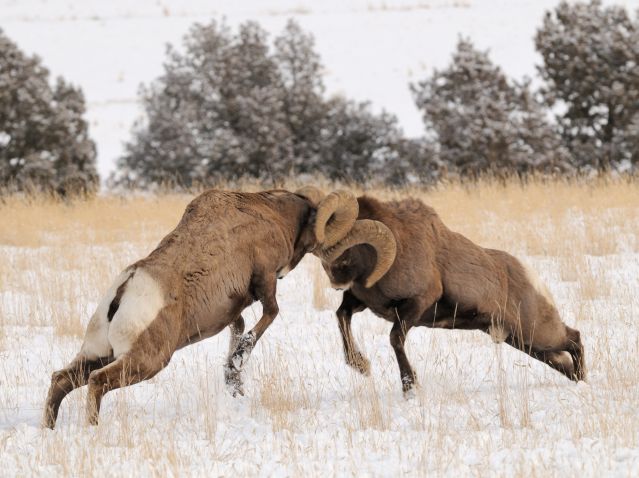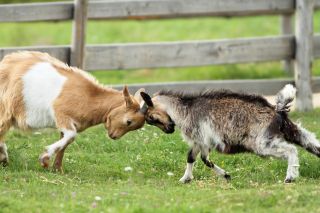Animal Behavior
What Can Headbutting Goats Reveal About Brain Injury?
Researchers look to nature for animal models of neurodegeneration.
Posted October 30, 2023 Reviewed by Devon Frye
Key points
- Male bovids (sheep and goats) are among the animals that headbutt as part of their natural behaviors.
- In the long-term, the accumulation of head impacts likely causes neurodegeneration in bovids.
- Male bovids risk long-term brain injury for the short-term goal of passing on their genes.
- Goats and sheep may be apt models of how acute brain injuries can lead to chronic neurodegeneration.
Headbutting fights between male bovids (the family that includes cattle, oxen, goats, sheep, and buffalo) look and sound dramatic.

“They hit very hard,” says Nicole Ackermans, who leads the Comparative Vertebrate Neurodegeneration Lab at the University of Alabama. “We are working with pygmy goats right now and even they hit impressively hard.”
While all male bovids wield horns to impress potential mates, some species—notably sheep, goats, and muskoxen—engage in high-force headbutting fights for herd dominance. Males face each other, lower their heads, and charge at peak running speed, ramming head-to-head, sometimes dozens of times in a row.
It’s only natural to wonder what those kinds of repeated forces do to the animals’ brains, says Ackermans. She studies the brains of headbutting animals to better understand how injuries can add up and lead to neurodegeneration. Ackermans hopes this research will fill gaps in our knowledge of how neurodegenerative disorders, such as Alzheimer’s disease and chronic traumatic encephalopathy (CTE), develop over time in humans.
The Cost of Dominance
The suggestion that headbutting animals may incur brain injuries is not new, but Ackermans was among the first researchers to specifically look for evidence of naturally caused brain injury in wild bovids. In a study published last year, she and her colleagues examined the brains of male muskoxen and bighorn sheep under the microscope for evidence of traumatic brain injury. The analyses revealed accumulations of phosphorylated tau, a protein released by injured and dying neurons.
“What’s more, the pattern looked like early stage CTE in a human brain, in that there was a lot of damage around the cortical sulci, the folds of the brain,” says Ackermans. This is where head impact forces are most concentrated and likely to create cellular damage, so “this pattern has to be due to trauma and not just aging.”
At first glance, these results might seem counterintuitive: Why would animals evolve to engage in a behavior that results in brain injury? In a new paper in the journal Trends in Neurosciences, Ackermans describes the evolutionary tradeoff that has allowed headbutting fights to persist among bovids.

Basically, male goats, sheep, and muskoxen don’t need to be able to completely withstand repetitive head impacts. “All they need to do is live long enough to reproduce, and that’s what matters,” says Ackermans. “I’ve been quoted as saying, ‘Bighorn sheep don’t need to do crossword puzzles.’ It doesn’t matter if they have dementia, as long as they pass on their genes.”
Like most bovids, bighorn sheep have a harem society with one dominant male who mates with all the females in the herd. Headbutting fights are how dominance is determined. Ackermans suspects that males may possess some features that protect them in the short-term, such as thicker skulls, but that, over time, brain trauma may accumulate.
“If a male keeps winning headbutting contests, he may get a little bit of brain damage, but he also gets to father the next generation,” says Ackermans. “Bighorn sheep only live about 10 years in the wild anyway, so that’s probably not enough time to accumulate really serious, chronic brain injuries.”
The School of Hard Knocks
In humans, how and when acute traumatic brain injury develops into chronic neurodegeneration remains poorly understood.
“We don’t know how many brain injuries you need, how hard they have to be, and at what point acute injuries transform into something more chronic,” says Ackermans.
These questions are complex to address in live human brains, so researchers have turned to animal models of brain injury, mostly rodents. Ackermans says these models can be valuable for some specific applications, but results can often be difficult to translate to humans. She thinks domestic bovids like sheep and goats show potential as a more naturalistic model for traumatic brain injury.

Bovids’ brains are closer in size and anatomy to that of humans (e.g., they have brain folds, while mouse brains are smooth). They also have longer lifespans than mice, allowing neurodegenerative processes to be studied over extended timescales. Domestic sheep have even been shown to develop Alzheimer’s-like brain changes, potentially exacerbated by headbutting.
But Ackermans’ lab is not just limited to bovids. “There’s a whole variety of species that hit their heads,” she says. “Every time I talk about this topic, someone from a different field brings me another example.”
These include birds like woodpeckers as well as gannets, diving birds that hit the water extremely hard, and helmeted hornbills, which collide head-first in mid-air. Parrot fish and some species of forest hog headbutt. Headbutting is even a courtship behavior seen in male sperm whales.
“I don’t know if headbutting gives them brain damage,” says Ackermans. “No one has given me a sperm whale brain yet.”
Overall, Ackermans says that investigating the consequences of hard head impacts in nature may teach us how to prevent or ameliorate neurodegeneration in humans. “There are all kinds of diverse examples of animals that hit their heads as part of their natural behaviors,” she says. “Whether they incur brain injury is the novel question that we want to study.”
References
Ackermans NL. Neurobiological tradeoffs of headbutting bovids. Trends Neurosci. 2023 Sep 6:S0166-2236(23)00192-3. doi: 10.1016/j.tins.2023.08.004.
Ackermans NL, Varghese M, Williams TM, Grimaldi N, Selmanovic E, Alipour A, Balchandani P, Reidenberg JS, Hof PR. Evidence of traumatic brain injury in headbutting bovids. Acta Neuropathol. 2022 Jul;144(1):5-26. doi: 10.1007/s00401-022-02427-2.




